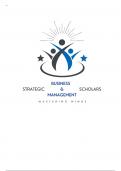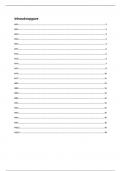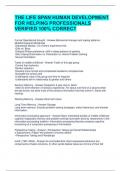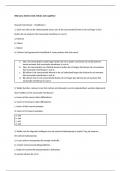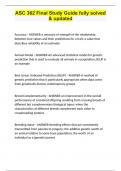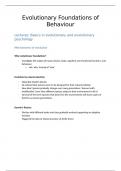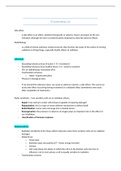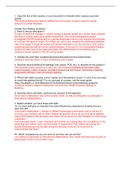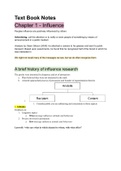Developmental Psychology
Chapter 1
1.1
Development - systematic changes and continuities in the individual that occur
between conception and death, or from “womb to tomb.” systematic – orderly,
patterned, relatively enduring
Physical development, cognitive development, psychosocial development
(motives, emotions, personality traits, etc.)
Growth – physical changes that occur from conception to maturity, biological aging –
detoriation of organism that leads to their death
gain-stability-loss model is traditional, but actually there are losses and gains
throughout life
Aging – more than biological aging, includes a range of physical, cognitive, and
psychosocial changes
Emerging adulthood – 18-25 – between adolescence and full-fledged adulthood –
postponing adulthood for education – distinct in developed countries, but also in
developing – exploring identity, unstable lives, self-focused, feel in between, believe
in limitless possibilities
Culture – shared understanding and way of life of a people, beliefs, values, and
practices concerning the nature of humans in different phases of the life span –
influences how we live our lives
Age grade – socially defined age group in a society
rite of passage - a ritual that marks a person’s “passage” from one status to another
social clock—a person’s sense of when things should be done and when he or she
is ahead of or behind the schedule dictated by age norms.
,socioeconomic status (SES) – poverty has great influence no matter race or ethnicity
Historical changes:
a) childhood was not always considered the age of innocence (e.g., medieval
Europe)
b) adolescence – not a distinct period until the 19th century, due to mandatory
education
c) emerging adulthood – defined in the 21st century
d) middle age as emptying of the nest – parents live long enough to see their
children grow up
e) old age as retirement – 20th century, before they worked until they died
life expectancy – 79 compared to 47 in 1900
nature– nurture issue, or the question of how biological forces and environmental
forces act and interact to make us what we are
Nature – influence of heredity, some aspects are innate, some are the
product of maturation – biological unfolding of the individual as sketched out
in genes
Nurture - change in response to environment—all the external physical and
social conditions, stimuli, and events that can affect us, emphasis on learning
– experience brings permanent changes in thoughts, feelings, or behaviour
it is nature AND nurture
1.2
Goals of studying of life-span development: describing, predicting, explaining, and
optimizing development
evidence-based practice - ensuring that the curricula and treatments therapists
provide have been demonstrated to be effective
Beginnings of developmental psychology
Baby biographies – observation of the growth and development of the
children of scholars – Charles Darwin – his own theory of evolution influenced
the early theories of human development – not very useful due to difficulty of
comparison, lack of ability to generalize, and lack of objectivity
Stanley Hall – founder of developmental psychology, first APA president –
coined the term adolescence – teenagers emotionally unstable (incorrect) but
there are great changes – storm and stress – also the effect of aging
Modern life-span perspective
gerontology - the study of aging and old age
true life-span perspective on human development began to emerge in the
60s/70s
, Paul Baltes’ 7 key assumptions of the life-span perspective:
1. Development is a lifelong process.
2. Development is multidirectional.
3. Development involves both gain and loss.
4. Development is characterized by lifelong plasticity (capacity to change in
response to experience, whether positive or negative)
neuroplasticity - brain’s remarkable ability to change in response to
experience throughout the life span
5. Development is shaped by its historical-cultural context.
6. Development is shaped by its historical-cultural context.
7. Development must be studied by multiple disciplines.
1.3
The scientific method involves generating ideas
and testing them by making observation
theory—a set of concepts and propositions
intended to describe and explain certain
phenomena
hypotheses (predictions) – regarding a set of
observations
Good theory – internally consistent, supported by
data, falsifiable
Sample, population
Random sample – picked randomly from the
desired population
Data collection - verbal reports, behavioural observations, and physiological
measurements
Verbal reports: Interviews, written questionnaires or surveys, ability and achievement
tests, and personality scales all involve asking people questions, either about
themselves (self-report measures) or about someone else (for example, child
behaviour as reported by informants such as parents or teachers)
Behavioural reports: - naturalistic observation (in everyday surroundings),
structured observation; that is, they create special stimuli, tasks, or situations
designed to elicit the behaviour of interest.
Physiological measures – fMRI (blood flow in an active area in the brain)
Case study, experiment (IV and DV)
Experiment features: random assignment, manipulation of the IV, experimental
control (all factors except for the IV are controlled or held constant)
, Strength of experiments – exploring the causal relationship, Limits – laboratory
settings that might not be true in the real world, not always ethically correct
Correlational method, correlation coefficient – problems – DIRECTIONALITY
PROBLEM (the direction of the cause-effect relationship could be reverse), THIRD
VARIABLE PROBLEM - NO CAUSALITY
understanding of why humans develop as they do is best advanced when the results
of different kinds of studies converge
When we have the results of multiple studies addressing the same question, they
can be synthesized to produce overall conclusions through the research method of
meta-analysis
infants have a video deficit, a difficulty learning as much from video presentations
as they do from face-to-face presentations
Cross-sectional design - performances of people of different age groups, or
cohorts, are compared – information about age difference
cohort is a group of individuals born at the same time, either in the same year
or within a specified span of years
Age effects are relationships between age (a rough proxy for changes brought
about by nature and nurture) and an aspect of development.
Cohort effects are the effects of being born as a member of a particular cohort or
generation in a particular historical context.
Longitudinal design - one cohort of individuals is assessed repeatedly over time-
information about age changes
Time-of-measurement effects in developmental research are the effects of
historical events and trends occurring when the data are being collected and that can
affect anyone alive at the time
A sequential design combines the cross-sectional approach and the
longitudinal approach in a single study
They can tell researchers
1. which age-related trends are truly developmental in nature and reflect how
most people, regardless of cohort, can be expected to change over time (age
effects)
2. which age trends differ from cohort to cohort and suggest that each
generation is affected by its distinct growing-up experiences (cohort effects);
and
3. which trends suggest that events during a specific period of history affect all
cohorts alive at the time (time-of-measurement effects)
Chapter 1
1.1
Development - systematic changes and continuities in the individual that occur
between conception and death, or from “womb to tomb.” systematic – orderly,
patterned, relatively enduring
Physical development, cognitive development, psychosocial development
(motives, emotions, personality traits, etc.)
Growth – physical changes that occur from conception to maturity, biological aging –
detoriation of organism that leads to their death
gain-stability-loss model is traditional, but actually there are losses and gains
throughout life
Aging – more than biological aging, includes a range of physical, cognitive, and
psychosocial changes
Emerging adulthood – 18-25 – between adolescence and full-fledged adulthood –
postponing adulthood for education – distinct in developed countries, but also in
developing – exploring identity, unstable lives, self-focused, feel in between, believe
in limitless possibilities
Culture – shared understanding and way of life of a people, beliefs, values, and
practices concerning the nature of humans in different phases of the life span –
influences how we live our lives
Age grade – socially defined age group in a society
rite of passage - a ritual that marks a person’s “passage” from one status to another
social clock—a person’s sense of when things should be done and when he or she
is ahead of or behind the schedule dictated by age norms.
,socioeconomic status (SES) – poverty has great influence no matter race or ethnicity
Historical changes:
a) childhood was not always considered the age of innocence (e.g., medieval
Europe)
b) adolescence – not a distinct period until the 19th century, due to mandatory
education
c) emerging adulthood – defined in the 21st century
d) middle age as emptying of the nest – parents live long enough to see their
children grow up
e) old age as retirement – 20th century, before they worked until they died
life expectancy – 79 compared to 47 in 1900
nature– nurture issue, or the question of how biological forces and environmental
forces act and interact to make us what we are
Nature – influence of heredity, some aspects are innate, some are the
product of maturation – biological unfolding of the individual as sketched out
in genes
Nurture - change in response to environment—all the external physical and
social conditions, stimuli, and events that can affect us, emphasis on learning
– experience brings permanent changes in thoughts, feelings, or behaviour
it is nature AND nurture
1.2
Goals of studying of life-span development: describing, predicting, explaining, and
optimizing development
evidence-based practice - ensuring that the curricula and treatments therapists
provide have been demonstrated to be effective
Beginnings of developmental psychology
Baby biographies – observation of the growth and development of the
children of scholars – Charles Darwin – his own theory of evolution influenced
the early theories of human development – not very useful due to difficulty of
comparison, lack of ability to generalize, and lack of objectivity
Stanley Hall – founder of developmental psychology, first APA president –
coined the term adolescence – teenagers emotionally unstable (incorrect) but
there are great changes – storm and stress – also the effect of aging
Modern life-span perspective
gerontology - the study of aging and old age
true life-span perspective on human development began to emerge in the
60s/70s
, Paul Baltes’ 7 key assumptions of the life-span perspective:
1. Development is a lifelong process.
2. Development is multidirectional.
3. Development involves both gain and loss.
4. Development is characterized by lifelong plasticity (capacity to change in
response to experience, whether positive or negative)
neuroplasticity - brain’s remarkable ability to change in response to
experience throughout the life span
5. Development is shaped by its historical-cultural context.
6. Development is shaped by its historical-cultural context.
7. Development must be studied by multiple disciplines.
1.3
The scientific method involves generating ideas
and testing them by making observation
theory—a set of concepts and propositions
intended to describe and explain certain
phenomena
hypotheses (predictions) – regarding a set of
observations
Good theory – internally consistent, supported by
data, falsifiable
Sample, population
Random sample – picked randomly from the
desired population
Data collection - verbal reports, behavioural observations, and physiological
measurements
Verbal reports: Interviews, written questionnaires or surveys, ability and achievement
tests, and personality scales all involve asking people questions, either about
themselves (self-report measures) or about someone else (for example, child
behaviour as reported by informants such as parents or teachers)
Behavioural reports: - naturalistic observation (in everyday surroundings),
structured observation; that is, they create special stimuli, tasks, or situations
designed to elicit the behaviour of interest.
Physiological measures – fMRI (blood flow in an active area in the brain)
Case study, experiment (IV and DV)
Experiment features: random assignment, manipulation of the IV, experimental
control (all factors except for the IV are controlled or held constant)
, Strength of experiments – exploring the causal relationship, Limits – laboratory
settings that might not be true in the real world, not always ethically correct
Correlational method, correlation coefficient – problems – DIRECTIONALITY
PROBLEM (the direction of the cause-effect relationship could be reverse), THIRD
VARIABLE PROBLEM - NO CAUSALITY
understanding of why humans develop as they do is best advanced when the results
of different kinds of studies converge
When we have the results of multiple studies addressing the same question, they
can be synthesized to produce overall conclusions through the research method of
meta-analysis
infants have a video deficit, a difficulty learning as much from video presentations
as they do from face-to-face presentations
Cross-sectional design - performances of people of different age groups, or
cohorts, are compared – information about age difference
cohort is a group of individuals born at the same time, either in the same year
or within a specified span of years
Age effects are relationships between age (a rough proxy for changes brought
about by nature and nurture) and an aspect of development.
Cohort effects are the effects of being born as a member of a particular cohort or
generation in a particular historical context.
Longitudinal design - one cohort of individuals is assessed repeatedly over time-
information about age changes
Time-of-measurement effects in developmental research are the effects of
historical events and trends occurring when the data are being collected and that can
affect anyone alive at the time
A sequential design combines the cross-sectional approach and the
longitudinal approach in a single study
They can tell researchers
1. which age-related trends are truly developmental in nature and reflect how
most people, regardless of cohort, can be expected to change over time (age
effects)
2. which age trends differ from cohort to cohort and suggest that each
generation is affected by its distinct growing-up experiences (cohort effects);
and
3. which trends suggest that events during a specific period of history affect all
cohorts alive at the time (time-of-measurement effects)

